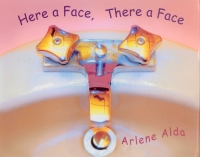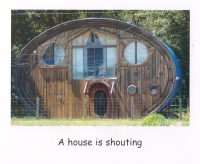| ________________
CM . . .
. Volume XIV Number 12 . . . .February 8, 2008 
 |
Here a Face, There a Face.
Arlene Alda.
Toronto, ON: Tundra Books, 2008.
24 pp., hardcover, $18.99.
ISBN 978-0-88776-845-3.
Preschool-grade 1 / Ages 2-6.
Review by Keith McPherson.
**** /4
Reviewed from f&g's.
|
| |
|

As most parents have experienced, the first visual skills that human infants develop is the ability to see color, shape, and recognize faces. Here a Face, There a Face cleverly taps into this ability and presents readers with a series of very clear, colourful and dynamic photographs of everyday items found both inside and outside of children's homes, and then challenges readers to find the hidden faces.
This is the ninth children's book that features text and photographs from author/photographer, Arlene Alda. Like her previous work, the photographs reflect Alda's experience as a teacher and skill in playfully and artfully integrating learning into children's everyday experience.
The photographs consist largely of easily identified objects that most children find both in and outside their homes, with examples coming from both rural and urban settings. Images are intentionally cropped to provide readers with minimal amounts of visual disturbance making it relatively easy for the very young to find faces on the page.
 Sentence structure is simple, but not stilted, and encourages children to see and hear the faces on the page. The book is excellent for developing vocabulary that describes facial abilities and functions, like staring, glancing, looking, crying, growing (hair), shouting, whistling, etc. Even though some text will be hard for this age group to independently sound out, a little adult assistance and a closer inspection at the supporting visuals will help students understand the new vocabulary.
Sentence structure is simple, but not stilted, and encourages children to see and hear the faces on the page. The book is excellent for developing vocabulary that describes facial abilities and functions, like staring, glancing, looking, crying, growing (hair), shouting, whistling, etc. Even though some text will be hard for this age group to independently sound out, a little adult assistance and a closer inspection at the supporting visuals will help students understand the new vocabulary.
Although the main intent of the book is to have fun finding faces in everyday objects, I found the book also presents parents and teachers with enough content to further challenge and extend young children's' visual meaning-making skills. For example, adults can challenge young readers to predict what the object/s are that make up the face, and where one might find it/them (e.g., this face can be found in the reflection of a garbage can in the park). Similarly, the book can be used to initiate a unit or exploration into recognizing and understanding human feelings through facial expression.
Although the text in this book is clearly aimed at K-1 readers, the photographs will be enjoyed by all ages. I thoroughly enjoyed finding the faces on the page with my five-year-old, and, in many cases, he was quicker at finding the faces than I. Don't be surprised, though, to find the book follows you and your young ones out into the real world as you start seeing faces in everything around you. Pure visual delight!
Highly Recommended.
Keith McPherson has been a primary and elementary teacher and teacher-librarian in BC since 1984 and is currently the coordinator of the Language and Literacy Education Research Centre at the University of British Columbia.

To comment
on this title or this review, send mail to cm@umanitoba.ca.
Copyright © the Manitoba Library Association. Reproduction for personal
use is permitted only if this copyright notice is maintained. Any
other reproduction is prohibited without permission.
NEXT REVIEW |
TABLE OF CONTENTS FOR THIS ISSUE
- February 8, 2008.
AUTHORS |
TITLES |
MEDIA REVIEWS |
PROFILES |
BACK ISSUES |
SEARCH |
CMARCHIVE |
HOME |

 Sentence structure is simple, but not stilted, and encourages children to see and hear the faces on the page. The book is excellent for developing vocabulary that describes facial abilities and functions, like staring, glancing, looking, crying, growing (hair), shouting, whistling, etc. Even though some text will be hard for this age group to independently sound out, a little adult assistance and a closer inspection at the supporting visuals will help students understand the new vocabulary.
Sentence structure is simple, but not stilted, and encourages children to see and hear the faces on the page. The book is excellent for developing vocabulary that describes facial abilities and functions, like staring, glancing, looking, crying, growing (hair), shouting, whistling, etc. Even though some text will be hard for this age group to independently sound out, a little adult assistance and a closer inspection at the supporting visuals will help students understand the new vocabulary.